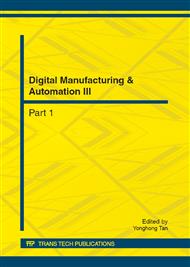p.651
p.656
p.661
p.666
p.673
p.679
p.683
p.688
p.693
Design and Analysis of a Robot-Assisted Manipulator in Retinal Vascular Bypass Surgery
Abstract:
Retinal vascular bypass surgery (RVBS) is a kind of complicated operation, with high precision and dexterous manipulation limited to small workspace. It is necessary to design a robot-assisted manipulator for performing such a task. The process of RVBS is described according to clinic operation at first. The motion of surgeon and workspace of surgical instruments are analyzed; correspondingly, motions of robot-assisted manipulator are obtained. Then, mechanism of manipulator including remote center of motion (RCM) is proposed through considering constraints induced by pierce points of sclera. Finally, inverse kinematics of the proposed robot-assisted manipulator is done to realize retinal surface motion. The analysis results show the end-effectors of robot-assisted manipulator can reach arbitrary position on the retinal surface.
Info:
Periodical:
Pages:
673-678
Citation:
Online since:
July 2012
Authors:
Price:
Сopyright:
© 2012 Trans Tech Publications Ltd. All Rights Reserved
Share:
Citation:


